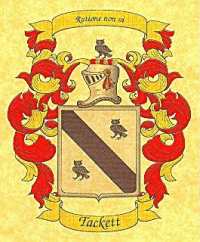
the text on this page was taken from
The Bevins Genealogy Pages

The Ancient History of
the
Distinguished Surname
Tackett
According to the Venerable Bede, the “Father of English History” who was born in 673, the Pictish race, one of the founding races of the British Isles, arrived in Scotland from Brittany about the 15th century B.C. From France the Picts had sailed northward to Ireland. The ancient Monarchies of Ireland refused them permission to land, but they were allowed to settle in the eastern part of Scotland on condition that all their Kings marry Irish Princesses. This established a matriarchal hierarchy, first in the annals of British History.
The Family name Tackett is believed to be descended from this source.
Nechtan was the first recorded Pictish King about 724 A.D., although, according to Roman history, many Pictish kings before him had fought gallantly at Hadrian’s Wall against the Roman invasion many centuries before. From the north, after the year 900,the Picts were invaded by the Orcadian Vikings who penetrated as far south as Caithness, and they were left with a territory on the eastern coast of Scotland from Aberdeen, south to Edinburgh.
From some of the many early documents researchers examined such records as the Inquisitio, 1120 A.D., the Black Book of the Exchequer, the Exchequer Rolls of Scotland, The Ragman Rolls, the Chronicles of the Picts and Scots and various other cartularies of parishes in Scotland. From these archives they produced the early records of the name in Rossshire where they determine the rate of taxation of their subjects.
The surname Tackett was found in many different forms and spellings. From time to time the surname was spelt MacTaggart, MacTargart, MacIntaggart, MacTuggart, MacToggart, MacTaggert, MacTeggart, Taggart, Tagart, Tegert, Teggert, Teggart, Intaggart, Tuggart, Toggartt, and some of these versions are still used today. These changes in spelling frequently occurred even between father and son. One clanswoman on record was born with of her name, married with another and died yet yet another. Scribes, church people selected their own version of what they thought the spelling should be.
The family name Tackett emerged as a Scottish Clan or family in this territory. More specifically they developed in their original territories of Ross where they were recorded as a family of great antiquity seated with manor and estates in that shire. One of the first on record was Ferchar, son of the Red Priest of Applecross in Ross. He was knighted by King Alexander of Scotland in 1215 for his assistance in subduing the rebellious clans of Moray. The Mackintaggart, as their chief was known, presented the King with a number of severed heads of Moray Clan Chiefs and Chieftains. He eventually became the Earl of Ross. The Clan was generally a rebellious Clan themselves and throughout history there were records of their misdeeds against local government and royalty. Patrick Taggart was a witness in Dumfries in 1544; Andrew Tagart was recorded in Underwood in 1678 and Christian Taggart was recorded in Inglistoun, in the same year, both in Kirkcudbrightshire. In the religious conflicts of the 17th century Catherin MacTaggart was accused of witchcraft (because she was unwilling to convert to the ‘faith’). Notable amongst the Clan at this time was Earl of Ross.
Scotland, during the 16th 17th and 18th centuries, was ravaged by religious conflict. The newly found passionate fervour of Presbyterianism and the Church of Scotland rejected all who could not pass “The Test” of taking an oath of belief in the Church. Those failing the “Test” were sometimes burnt at the stake or, more kindly, banished to Australia, the Carolinas or the West Indies.
Many Clansmen were freely “encouraged” to migrate to Ireland. Families migrated from Scotland to Ireland with promises of cheap Irish land. They became known as the Scotch/Irish”. This distinguished family settled in Ulster in the 17th century, and there is a place name called Ballymacataggart in County Fermanagh, they had many variants of the name, including Attegart, Terrart and even Tiger.
The migration or banishment to the New World also continued, some when voluntarily from Ireland, but most went directly from Scotland, their home territories. Some even moved to the European continent. They sailed to the New World across the stormy Atlantic aboard the small sailing ships known as the “White Sails”, ships such as the Hector, the Rambler and the Dove. These overcrowded ships, sometimes spending two months at sea, were racked with disease, sometimes landing with only 60% of their original passenger lists.
In North America, some of the first migrants which could be considered kinsmen of the surname Tackett, or having a variation of the family surname spelling included Hugh, James, Mathew, Peter McTaggart all arrived in Philadelphia between 1840 and 1860; Charles, Hugh James, Thomas and William McTaggert all arrived in Philadelphia between 1840 and 1860; Joseph and Alexander Tagart settled in Philadelphia Pa. in 1838 and 1811 respectively: William Tagart settled in Charles Town S.C. in 1767; Peter and Mary Tegart, his wife, settled in New York State in 1823 with two children; Patrick Teggart settled in Philadelphia Pa. in 1864.
From the original ports of entry the immigrants moved westward, some to the middle west, some across the prairies to the west coast. During the American War of Independence some remained Loyal to the cause, whilst others became United Empire Loyalists and moved north to Canada.
Many prominent people were a part of this notable name Sir Andrew MacTaggart; Sir Ian MacTaggart; Sir William MacTaggart, President of the Scottish Academy; William McTaggart, Board Chairman; Wing Commander John Scott-Taggart.
Research has determined the above Coat of Arms to be the most ancient recorded for the family surname Tackett.
Certification # - 943320-12.10 H-3289
Copyright 1994, The Hall of Names Inc. All rights reserved 1-613-548-3409